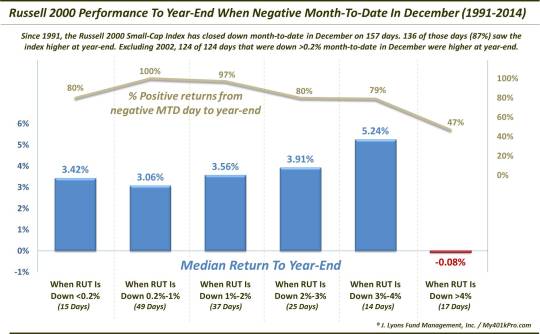Good Things Come In Small (Cap) Packages

December pullbacks in small-caps have led to extraordinarily favorable returns into year-end.
This post is an addendum to our piece on Monday regarding the strong December seasonality for small-caps. If you recall, since 1991, 21 of 24 years have seen the Russell 2000 (RUT) small-cap index close higher in December. And only 2002 saw the index close lower by at least 1%. Given the selloff in equities over the past 2 days, we thought we might expand on the topic by exploring the performance of small-caps following drawdowns within the month of December. Now, given the fact that 7 out of 8 Decembers see positive small-cap returns, it doesn’t take a rocket scientist to figure out that year-end returns following days when the RUT is down month-to-date are also strong. We thought we might provide a little color, though, just to drive home the point.
First off, from 1991 through 2014, the Russell 2000 has been lower month-to-date for December on 157 days spanning 20 different years. While the amount by which the RUT was lower
and the point in the month when the index was lower both vary widely across all of the instances, one thing has been consistent. The Russell 2000 has been higher at year-end following the vast majority of the days.
In this first chart, we show just how strong – and consistently strong – the Russell 2000 has been in recovering from these December losses. The chart divides up all of the days on which the Russell 2000 closed lower month-to-date in December by the amount they were down. It measures both the median return from those days until the year-end and the percentage of days that closed higher at year-end.

Almost across the board, the Russell 2000 has had a tendency to close the year sharply higher than where it stood on the day of its drawdown. The median return from such days into year-end is over 3% for all categories covering smaller than 0.2% losses up to 4% losses. The median return following intra-month losses of between 3% and 4% has been an impressive 5.24%. Only those losses greater than 4% saw the index struggle to make gains by year-end. So, perhaps it would behoove investors to have the Russell 2000 stay above that -4% threshold.
Furthermore, the consistency of the gains by year-end has been remarkable. Note, for example, that all 49 days exhibiting a month-date loss of between 0.2% and 1% closed the year higher. And 36 out of 37 days showing a December month-to-date loss of between 2%-3% ended the year higher.
What’s more is that, removing the RUT’s poor showing in December 2002, we see that every single day in a December since 1991 that saw a month-to-date loss of at least 0.2% finished the year higher. For the record, that would be 124 winners at year-end out of 124 days.
To illustrate, here is a chart showing the year-end returns of all 142 days, including 2002, that saw the Russell 2000 down for the month of December by at least 0.2%. The only 18 days that did not close the year higher were those in 2002. All 124 other days finished higher at year-end.

Now, hopefully I do not need to remind anyone that past performance is no guarantee of future results. Just because the Russell 2000 closed today at -2.3% for the month of December, it is not a lock to be higher at the end of the year. That said,
over the last 25 years
the seasonal tendency of small-caps to perform strongly and resiliently in the month of December is unmistakable.
At some point during this holiday season, you are likely to hear the phrase “good things come in small packages” (I know I’ll definitely hear it). For investors, if the historical pattern remains true, they may very well be getting a gift right now wrapped in a small-cap package.
_______________
More from Dana Lyons, JLFMI and My401kPro.
The commentary included in this blog is provided for informational purposes only. It does not constitute a recommendation to invest in any specific investment product or service. Proper due diligence should be performed before investing in any investment vehicle. There is a risk of loss involved in all investments.


